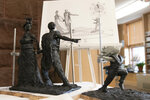Bristol Port Marker models ready for public input
For the month of December, models of each artist’s proposal will be on display at Rogers Free Library.
This item is available in full to subscribers.
Please log in to continue |
Register to post eventsIf you'd like to post an event to our calendar, you can create a free account by clicking here. Note that free accounts do not have access to our subscriber-only content. |
Day pass subscribers
Are you a day pass subscriber who needs to log in? Click here to continue.
Bristol Port Marker models ready for public input
“We are very excited about the quality of the designs we received,” said Stephan Brigidi of the submissions from the three artists selected to present their designs for the Memorial to be sited at Independence Park. “We knew Rhode Island artists have the talent and creativity for the challenge and the outcome has been terrific. It is going to be a fierce competition.”
The final decision will be made by the Port Marker board with input from the public. “While we know we won’t please everyone, we are looking forward to collecting the public’s reactions to each piece, both pro and con,” said Brigidi. “It’s a community project, so it’s important to hear from the community.”
For the month of December, models of each artist’s proposal will be on display at Rogers Free Library, where the public will have the opportunity to submit written comments.
Here are the submitted works:
Journey’s Passage
By Deborah Spears Moorehead
The eagle holds significance in African and Native American culture. The story of flight is a source of imagination that depicts freedom, and new futures. The eagle is seen returning Metacom’s Belt, one of the Wampanoags most sacred items that was taken following Metacomet’s rebellion and then lost. My proposed sculpture shows the majestic messenger eagle returning the belt to the Wampanoag Nation. The form of the belt next to the circle, forms the image of a broken chain. It also alludes to the motion of ocean waves. The water references the journey across the ocean.
My interviews with Black community leaders brought a vision to create a profound light within the sculpture that portrays the souls and signifies light over darkness to bring hope to the world. The open circular form, with a golden surface, will hold and intensify sunlight, and is strategically positioned for the winter solstice.
Braids are important in Native American culture as well as African American culture, connecting us to Mother Earth and Father Sky and holding prayers. African braiding holds symbols that historically would identify a person’s heritage in Africa, they were used to weave secret maps to freedom and continue to bind together Black culture past present and future. The figures do not portray male or female, facial type or ethnicity. They are abstract to portray the emotion of the spirit of humanity.
— Deborah Spears Moorehead on the submission named “Journey’s Passage”
A Space to Embrace the Future
By Deborah Baronas & Greg Spiess
While we can’t erase the past, we can embrace the future with the intent to heal. Our goal is to create a setting for education, contemplation and renewal, where we can embrace the future through art.
Through a series of waves that feature iconography from both Native and African American cultures, each symbol conveying a belief or principle for enlightenment, the wave recalls the transatlantic middle passage and symbolizes our voyage through to a more enlightened future.
Through an interplay of historical and contemporary images, cutouts cast shadows and patterns, the light transforms throughout the day interacting with the glass transparencies: creating an ever-changing atmosphere for contemplation.We invite the visitor to enter into a journey that honors the heritage, visions and contributions that these often overlooked, enslaved men, women and children have made to our society and illustrates how they can help lead us forward.
— Deborah Baronas & Greg Spiess on their submission named “A Space to Embrace the Future”
Our Ancestors Come With Us
By Spencer E. Evans
My concept for the memorial is based in the love and respect for my ancestors who endured the middle passage as well as a life in bondage long enough to be emancipated, which resulted in generations of descendants being able to live and thrive on this land today. My concept is also rooted in the same respect for the ancestors and descendants of Pokanoket people who lived in harmony with this land before any of us. Due to this love and respect, this project will not depict trauma. Our people are much more than stories of suffering, both of these groups have rich cultural identities without the lens of oppression and in spite of it.
Visually, the monument will include three bronze figures-two adults and one child. Both adult figures will have their bodies facing the Bristol Harbor, the first will be a woman. The position of her body will serve as a metaphor for the Pokanoket women who stood at the Cliffs of Sorrow waiting for their stolen families to return. The second figure, a man, will symbolize every African ancestor and descendent who possesses the viscerally sensational reminder that we are not in our home land. However, both their gazes will be fixed toward the child as the second points inland at the direction that the child is moving.
— Spencer E. Evans on the submission named “Our Ancestors Come With Us”













